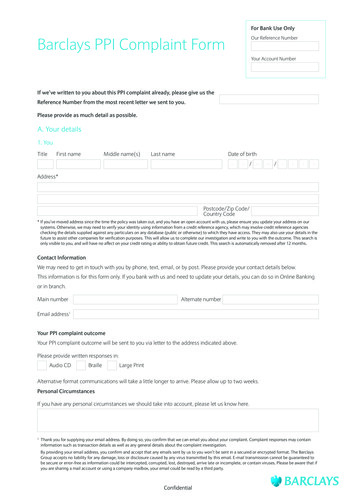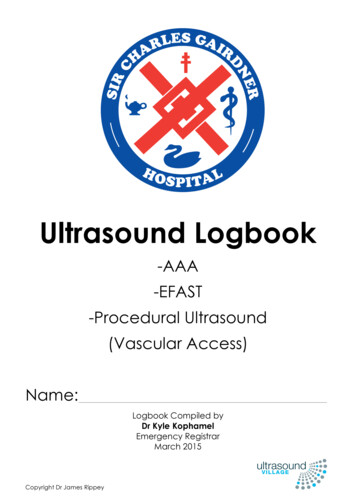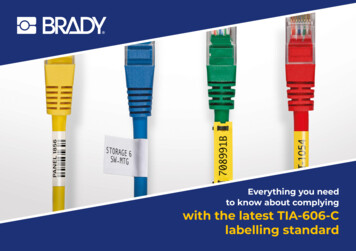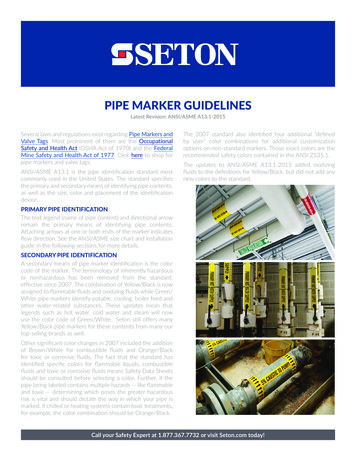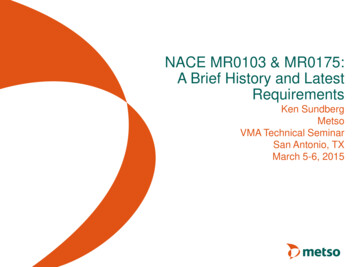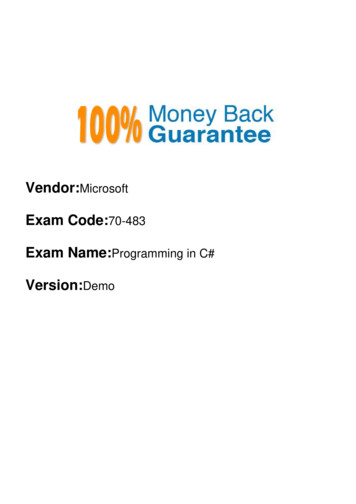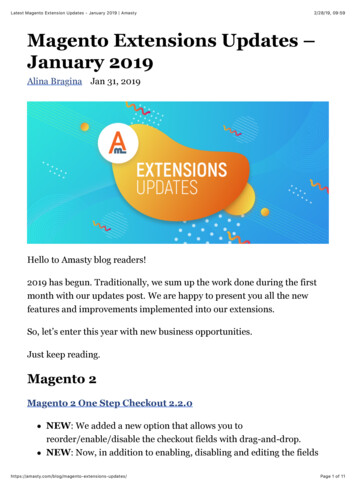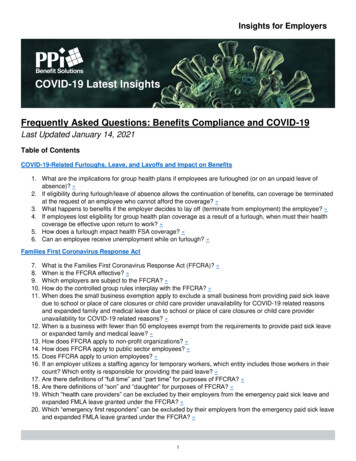
Transcription
Insights for EmployersCOVID-19 Latest InsightsFrequently Asked Questions: Benefits Compliance and COVID-19Last Updated January 14, 2021Table of ContentsCOVID-19-Related Furloughs, Leave, and Layoffs and Impact on Benefits1. What are the implications for group health plans if employees are furloughed (or on an unpaid leave ofabsence)? »2. If eligibility during furlough/leave of absence allows the continuation of benefits, can coverage be terminatedat the request of an employee who cannot afford the coverage? »3. What happens to benefits if the employer decides to lay off (terminate from employment) the employee? »4. If employees lost eligibility for group health plan coverage as a result of a furlough, when must their healthcoverage be effective upon return to work? »5. How does a furlough impact health FSA coverage? »6. Can an employee receive unemployment while on furlough? »Families First Coronavirus Response Act7.8.9.10.11.12.13.14.15.16.17.18.19.20.What is the Families First Coronavirus Response Act (FFCRA)? »When is the FFCRA effective? »Which employers are subject to the FFCRA? »How do the controlled group rules interplay with the FFCRA? »When does the small business exemption apply to exclude a small business from providing paid sick leavedue to school or place of care closures or child care provider unavailability for COVID-19 related reasonsand expanded family and medical leave due to school or place of care closures or child care providerunavailability for COVID-19 related reasons? »When is a business with fewer than 50 employees exempt from the requirements to provide paid sick leaveor expanded family and medical leave? »How does FFCRA apply to non-profit organizations? »How does FFCRA apply to public sector employees? »Does FFCRA apply to union employees? »If an employer utilizes a staffing agency for temporary workers, which entity includes those workers in theircount? Which entity is responsible for providing the paid leave? »Are there definitions of “full time” and “part time” for purposes of FFCRA? »Are there definitions of “son” and “daughter” for purposes of FFCRA? »Which “health care providers” can be excluded by their employers from the emergency paid sick leave andexpanded FMLA leave granted under the FFCRA? »Which “emergency first responders” can be excluded by their employers from the emergency paid sick leaveand expanded FMLA leave granted under the FFCRA? »1
Insights for EmployersCOVID-19 Latest 35.36.37.38.39.40.41.42.43.44.45.46.47.48.49.What are the consequences for an employer who refuses to comply with the FFCRA requirements? »How does an employee qualify for expanded FMLA? »What pay benefits are provided for under the expanded FMLA provision? »Can the emergency paid sick leave and expansion to FMLA be used intermittently? »If an employee has used 12 weeks of FMLA within the last 12 months, are they entitled to the emergencyFMLA expansion now? »Will FMLA forms be updated to reflect the new leave? »What new notice or documentation requirements, if any, apply to the expanded FMLA leave? »How does an employee qualify for the Emergency Paid Sick Leave? »Does a quarantine order due to voluntary travel (i.e., vacation) qualify an employee for Emergency Paid SickLeave? »Does a summer camp qualify as the “place of care” for an employee’s child for purposes of paid leave underthe FFCRA? »If a child’s school provides the options for in-person or remote learning, does choosing the remote learningoption qualify an employee for paid leave under the FFCRA? »Who is a “health care provider” that can advise a person to self-quarantine due to concerns related toCOVID-19 for purposes of paid sick leave? »What benefits are provided under the Emergency Paid Sick Leave? »How is the employee’s regular rate of pay calculated? »Does an employer with federal contracts covered by the Service Contract Act (SCA) and the Davis-BaconAct have to include fringe benefits in compensation for paid leave under the FFCRA? »May an employee use emergency paid sick leave for 10 days before their paid emergency FMLA extensionleave kicks in, if they are unable to work or telework because they are caring for a son or daughter who isout because school or daycare is closed? »Will emergency paid sick leave toll any waiting period for an employer’s health coverage? »What notice requirements, if any, apply to Emergency Paid Sick Leave? »Is an employer required to restore an employee’s position upon return from FFCRA leave? »What does the FFCRA require for cost-sharing related to COVID-19 screening and treatment? »If the cost for COVID-19 testing is waived, does this disqualify an HDHP for purposes of HSA-eligibility?What about for costs for COVID-19 treatment? »What are employers doing for employees that are ineligible for or previously waived group health plancoverage? »Does the FFCRA apply to employees who were on furlough prior to the FFCRA’s effective date? »What tax credits does the FFCRA provide? »What is the amount of the tax credit available to employers? »What are “qualified health expenses”? »How can employers start claiming the credit? »What documentation should an employer receive from an employee to substantiate the FFCRA paid sickleave or expanded FMLA leave? »Are federal income taxes withheld from qualified paid sick leave or expanded FMLA wages? Can employeesmake salary reduction contributions from the amounts? »2
Insights for EmployersCOVID-19 Latest Insights50. May a tax exempt employer receive the credits? »51. Are employers required to report the amount of FFCRA paid sick leave or expanded FMLA leave wagespaid to employees on Form W-2? »52. Where can I obtain more information regarding the tax credits, forms, and filing process? »53. Are there state and/or local laws mandates that apply? »54. HIPAA and ADA Protected Information »CARES Act FAQ55. What is the CARES Act? »56. How does the CARES act amend the rules concerning HDHP status and HSA eligibility as they pertain totelehealth coverage that is provided before the deductible is met? »57. Can reimbursement accounts (HSAs/FSAs/HRAs) now be used for over-the-counter drugs and menstrualproducts? »58. What are the additional COVID-19 tests that group health plans must cover without cost-sharing (or othermedical management requirements)? »59. Are plans required to cover COVID-19 antibody tests without cost sharing? »60. What future immunizations or vaccines related to COVID-19 will be required to be covered without costsharing? »61. How is COVID-19 test pricing determined? »62. Are student loan repayments now eligible for reimbursement as a fringe benefit? »CARES Act & Retirement Benefits63. How does the CARES Act impact hardship distributions for retirement plans? »64. How does the CARES Act impact plan loans from retirement plans? »65. Did the CARES Act waive required minimum distributions (RMD)? »Due Dates Extended for Certain Plan Notices and Filings & Mid-year Election Changes66. Which group health and retirement plans have an automatic extension for Form 5500 filing? »67. Do the new rules provide relief for any of the retirement plan compliance obligations? »68. What employer and employee notices and filing due dates have been extended under the rules jointly issuedby the Departments of Labor and Treasury on April 28, 2020? »69. How is an employer’s requirement to distribute a COBRA Election Notice impacted by the April 28, 2020rules? »70. Do COBRA participants have additional time under the new rules to submit COBRA premium payments? »71. An employee has a baby during the National Emergency, what is the date by which she must enroll the childin group coverage under HIPAA’s Special Enrollment Rights and the new rules? »72. An employer’s health FSA has a claims submission date of 90 days following the end of the plan year, whichwould have been March 31, 2020 for the 2019 plan year. Do employees have additional time to submitclaims under the new rules? »3
Insights for EmployersCOVID-19 Latest Insights73. Are grace period and carryover provisions for health FSAs and dependent care FSAs extended? »74. Are group health plans (including health FSAs) and dependent care FSAs able to permit mid-year electionchanges? »75. Are health FSAs permitted to provide a spend-down provision for terminated employees? »Other Frequently Asked Questions76.77.78.79.80.81.82.83.Can small business loans offered through the CARES Act be utilized for insurance premiums? »How does the CARES Act unemployment expansion impact furloughed employees? »With childcare and school closures, can changes be made to dependent care FSA (DCAP) elections? »If the cost for all telemedicine services is waived, does this disqualify an HDHP for purposes of HSAeligibility? »Can employers take the temperature of employees coming to work? »Did the extension of the individual tax filing deadline extend the date by which certain employee benefitscontributions can be made for 2019? »Can a former employee’s furlough be extended to avoid providing FFCRA leave? »Is the dependent child age increased for purposes of eligible expenses for a dependent care FSAreimbursement? »4
Insights for EmployersCOVID-19 Latest InsightsDISCLAIMER: Information presented in this FAQ is subject to change pending additional guidance from theDepartment of Labor, the Internal Revenue Service, and other regulatory agencies.COVID-19-Related Furloughs, Leave, and Layoffs and Impact on Benefits1. What are the implications for group health plans if employees are furloughed (or on an unpaid leaveof absence)? Generally speaking, the impact to benefits administration will depend on employer policies and plan documentation.More specifically, whether benefits can be extended during a furlough would depend upon the eligibility terms of thegroup health plan. The employer will also need to consider the employer mandate (if applicable), whether themonthly or look-back measurement methods are used, what is outlined in its Section 125 Plan Document as aqualifying event, and how long the furlough lasts.That said, employers will need to review their current documents (as explained below) and determine what benefitsare required to be provided. If benefit continuation is not required during the period of the furlough, the employercould consider amending the plan (which would require coordination with the insurance carrier or stop loss carrier).ERISA Plan Document and Any Employment ContractsAs noted above, an employer needs to look at the plan document and review the plan’s eligibility terms. This appliesto all benefit offerings, including medical, dental, vision, life, disability, etc. These provisions may specificallyaddress furloughs or leaves of absence and continued coverage. If there are any special employment contracts orcollective bargaining agreements in place, these should also be reviewed. If there are no special terms, then thestandard eligibility definition applies, which may require a certain number of hours worked to be considered full time.If the SPD or ERISA plan documents include a reservation of rights to amend the plan, the plan may be amended ifproper protocols are followed. However, to the extent the plan is fully insured (or self-insured with a stop-losspolicy), it will be important to ensure that the applicable third-party insurer, third party administrator, or stop-lossinsurer agrees to the extension of coverage.ACA Employer MandateLarge employers need to consider the employer mandate rules for medical coverage. If they are using the monthlymeasurement method, then an employee who has a change of status and is no longer eligible for coverage underthe plan terms would be terminated at the end of the month with COBRA offered for reduction of hours.If they are using the look-back measurement method and the employee was previously determined to be full-time ina measurement period, then the employee would remain eligible through the end of the stability period regardless ofthe number of hours they work. If the employee was continuously offered coverage as a full-time employee (i.e.,they were offered coverage after the waiting period), the change in status rules would seem to dictate that the5
Insights for EmployersCOVID-19 Latest InsightsDISCLAIMER: Information presented in this FAQ is subject to change pending additional guidance from theDepartment of Labor, the Internal Revenue Service, and other regulatory agencies.employees must be measured (and found to have worked less than 30 hours per week) for a period of three monthsbefore being terminated from coverage.Beyond that, if the employee just experiences a reduction in hours, then the employer can stop offering coverage—the employee wouldn’t be working 30 hours/week during the month, and therefore wouldn’t be a FT employee towhom the employer must offer coverage.Employers who use the look-back measurement method should also consider how the employer affordabilitymandate could be affected when an employee works zero hours and the employer wishes to continue to providecoverage to that employee. If the employer uses the Form W-2 safe harbor, they should consider whether theycharge the employee for coverage during the work stoppage period.Payment of ContributionsFor all sized employers, if an employee continues to be eligible under the plan, how would the employer receive theemployee premium contributions without a paycheck from which to make the deduction? Generally, employersmirror the rules for FMLA premium payment. The employer may require that employees pay premiums post-taxduring the furlough period by personal check, money order credit card or via electronic payment. The payments maybe due per pay period or per month. Employers should provide employees with written notice of the paymentmethod, due date and consequences for nonpayment (termination of coverage). Alternatively, the employer couldpermit the employee to pay upon return, but this is typically not preferred when the return date is unknown.Section 125 Cafeteria Plan Document and ReinstatementAll sized employers also need to consider the Section 125 cafeteria plan rules. Let’s say that an employee continuesto be eligible for coverage under the terms of the plan and/or employer mandate rules, but wants to drop coveragebecause of not being paid. Is this allowed? There is a qualifying event permitting employees to drop coverage basedon an unpaid leave of absence if the Section 125 Cafeteria Plan Document provides that such employees loseeligibility under the cafeteria plan. If they return to work within 30 days of dropping coverage, they would bereinstated to the same coverage with no chance to change elections.For a large employer subject to the employer mandate, if employees return to work after 30 days but within 13weeks, they would be reinstated to eligibility and would have the right to change elections. If they return beyond 13weeks – they could be required to meet a new waiting period or start a new measurement period.On May 12, 2020, the IRS issued IRS Notice 2020-29, which permits employees to make certain election changesunder a cafeteria plan during calendar year 2020 without a qualifying event.6
Insights for EmployersCOVID-19 Latest InsightsDISCLAIMER: Information presented in this FAQ is subject to change pending additional guidance from theDepartment of Labor, the Internal Revenue Service, and other regulatory agencies.Employees may: Drop coverage on themselves if they attest in writing that they have or will immediately enroll in othercomprehensive medical coverage (includes Medicare, Medicaid, CHAMPVA, TRICARE, individual coveragethrough the exchange, or other group coverage);Switch plan options offered by the employer;Add self, spouse, or dependent(s); orElect, increase, or decrease health FSA and dependent care FSA electionsThe change must be prospective. However, if the employer previously allowed such changes before the guidancewas issued, those actions are also covered by the relief. Employers are not required to provide employees with theopportunity to make these changes. If they choose to implement, they will need to obtain insurer approval (includinga stop loss insurer for a self-insured plan) and amend their Section 125 Cafeteria Plan Document accordingly byDecember 31, 2021.COBRAEligibility for group coverage also directly affects the question of when someone must be offered coverage throughCOBRA. To be COBRA eligible, the employee must experience both a COBRA-triggering event (which in thefurlough situation, would be a reduction of hours) AND a loss of eligibility for group health coverage. So, althoughfurloughed employees would be experiencing a reduction in hours (albeit temporarily), if the employees remaineligible for group health coverage, they would not be eligible for continuation coverage through COBRA.So COBRA would not need to be offered. In other instances, a longer furlough could cause a loss of eligibility, suchas when the employee is no longer working the requisite hours of service to be eligible. In this case, an offer ofCOBRA would be due.Employers that are considering extending COBRA for qualified beneficiaries that may be close to exhaustingCOBRA could potentially choose to extend COBRA. However, employers that are contemplating COBRAextensions should work closely with their carriers (if fully insured) or stop-loss carriers (if self-insured), and shouldcommunicate the extension clearly to impacted qualified beneficiaries. In addition, they’ll want to work with COBRAand other plan administrators to help administer the COBRA extension appropriately.Note that if an employer terminates its plan completely, then there is no COBRA obligation; the COBRAresponsibilities terminate with the plan. However, if the employer is part of a larger group of related employers(related through common ownership, sometimes called a ‘controlled group’), then the COBRA obligation mightspring over (transfer) to the related company. Employers should work with outside counsel in this situation, as theactual obligation depend heavily on the specific facts/circumstances.7
Insights for EmployersCOVID-19 Latest InsightsDISCLAIMER: Information presented in this FAQ is subject to change pending additional guidance from theDepartment of Labor, the Internal Revenue Service, and other regulatory agencies.2. If eligibility during a furlough/leave of absence allows the continuation of benefits, can coverage beterminated at the request of an employee who cannot afford the coverage? While a qualifying event under the cafeteria plan rules permit an election change when there is a change inemployment status (such as an unpaid leave of absence), the change must affect eligibility under the plan.Otherwise it wouldn’t be a qualifying event. That said, there’s a second qualifying event that permits an electionchange when there is a reduction of hours even if there is no impact on eligibility (assuming the employer’s Section125 plan permits); however, the employee must intend to enroll in another plan offering minimum essentialcoverage.Similarly, under guidance issued May 12, 2020, an employee may drop coverage prospectively during calendar year2020 if they attest in writing that they are enrolled in or will immediately enroll in other comprehensive coverage.Considering the circumstances, some employees whose hours are reduced may not be able to afford othercoverage. A reduction in a participant's or family's income, standing alone, is not a permitted election change event.3. What happens to benefits if the employer decides to lay off (terminate from employment) theemployee? In the case of a true layoff (termination of employment), the employee should be offered COBRA. Because there isa COBRA-triggering event (termination of employment coupled with a loss of eligibility), COBRA would be offeredfor any plans subject to COBRA (including medic
Jan 14, 2021 · 72. An employer’s health FSA has a claims submission date of 90 days following the end of the plan year, which would have been March 31, 2020 for the 2019 plan year. Do employees have additional ti

